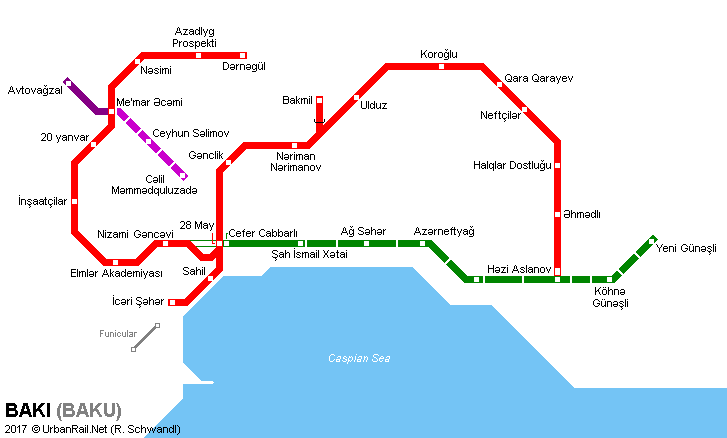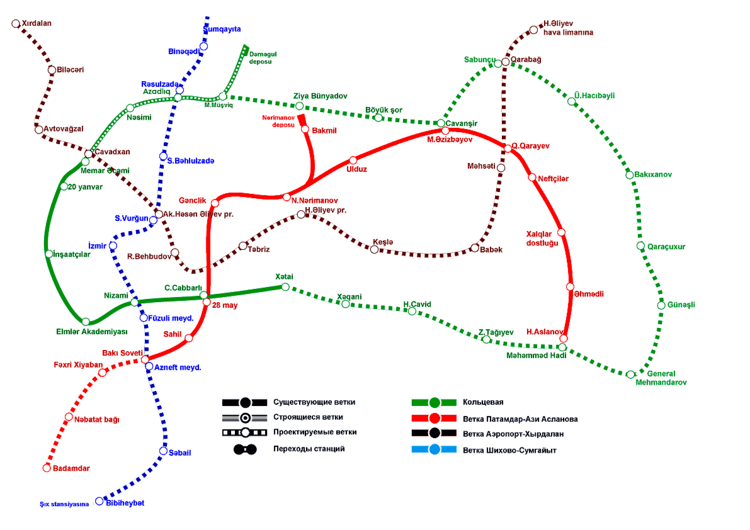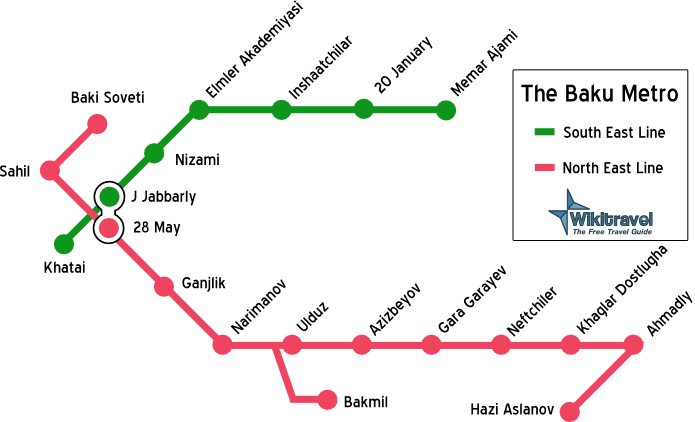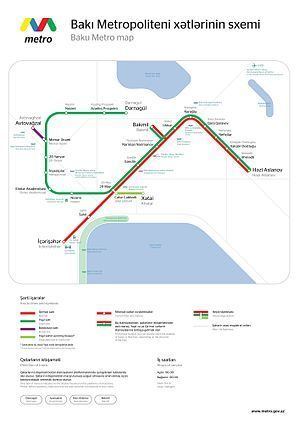Native name Bakı Metropoliteni Annual ridership 222.0 million (2015) Number of stations 25 Transit type Rapid transit | Owner Bakı Metropoliteni Chief executive Zaur Huseynov Began operation November 6, 1967 Number of lines 3 Number of vehicles 228 | |
 | ||
Daily ridership 608,200 (daily average, 2015) Similar Memar Əcəmi, Avtovağzal, Həzi Aslanov, 28 May, Dərnəgül | ||
Baku metro
Baku Metro (Azerbaijani: Bakı Metropoliteni) is a rapid transit system serving Baku, the capital of Azerbaijan. First opened on 6 November 1967 during the time of the Soviet Union, it has features typical of ex-Soviet systems, including very deep central stations and exquisite decorations that blend traditional Azerbaijani national motifs with Soviet ideology. At present the system has 36.66 kilometres (22.78 mi) of bi-directional tracks, made up of three lines served by 25 stations. The metro is the only one constructed in Azerbaijan, and was the fifth built in the Soviet Union. In 2015, it carried 222.0 million passengers, which yielded an average daily ridership of approximately 608,200.
Contents
- Baku metro
- History
- Expansion plans
- Operation
- Ticketing
- Wi fi and mobile phone coverage
- Rolling stock
- Bombing of 1994
- Fire of 1995
- References

History

During the final decades of the Russian Empire the port city of Baku became a large metropolis due to the discovery of oil in the Caspian Sea. By the 1930s, it was the capital of the Azerbaijani SSR and the largest city in Soviet Transcaucasia. The first plans for a rapid-transit system date to the 1930s, with the adoption of a new general plan for city development.

Having survived the Second World War without falling to the Germans, and furthermore becoming a strategic hub of the Caucasus, the population passed the one million mark, a requirement of Soviet law for allowing construction of a metro system. In 1947, the Soviet Cabinet of Ministers issued a decree authorizing its construction, which began in 1951. On November 6, 1967, Baku Metro became the Soviet Union's fifth rapid-transit system when the first 6.5 kilometers of track and a depot were inaugurated, in honor of the fiftieth anniversary of the October Revolution.

Due to the city's unique landscape, Baku Metro did not have the typical Soviet "triangle" layout of development, and instead had two elliptical lines which crossed each other in the center of the city at the Baku Railway Terminal. Thus one line would begin at the southwestern end of the city, and cross on a northeastern axis to follow the residential districts on the northern edge of the city and then snake along to the southeastern and ultimately southern end. This was inaugurated in three stages: Ulduz (1970) and Neftçilər (1972), followed by Ahmedli (1989) and finally Hazi Aslanov (2002), completing the first line. Additionally, in 1970 a branch was opened to a station built in a depot, Bakmil.

The second line was to parallel the Caspian coast from Hazi Aslanov through Baku's industrial districts, meeting the first line again at the Baku Railway Terminal, and then continuing westwards before turning north to join Baku's northwestern districts. To accelerate construction, a branch was opened from May 28 station to Khatai in 1968, and in 1976 in the opposite direction towards Nizami. The second and first line used the same station (May 28). This posed no serious problems initially, as the line was two stations long, but when the second stage opened in 1985, lengthening the line to 8 stations (Memar Ajemi), construction of a transfer was desperately needed.
In 1993, the first stage of the transfer station Jafar Jabbarli came in operation, but the end of the Soviet Union, political unrest, military conflict in Nagorno-Karabakh and the financial collapse which followed effectively paralyzed any construction attempts in Baku. Furthermore, during the 1990s two catastrophes took place: on March 19 and July 3, 1994, two terrorist attacks killed 27 and injured 91 people, and on October 28 of the following year a fire in a crowded train killed 289 and injured 265 others, the world's deadliest subway disaster.
Only in the late 1990s could construction restart. The first project was the completion of Hazi Aslanov station, partly sponsored by the European Union. In the mid-2000s, construction of the northern end of the second line, abandoned since 1994, was restarted with Nasimi station opening in October 9, 2008.
Expansion plans
At present, there are several expansion projects planned, two of which are under construction. In 2011, the Chief Executive of the Baku Metro, Taghi Ahmadov, announced plans to construct 76 new stations by 2030. Currently, eight stations and two train depots are under construction. These will serve the new bus complex as well as Heydar Aliyev International Airport.
The signalling, supervision and telecommunication systems for Phase 1 of the Purple Line will be upgraded by Thales.
Three new stations were planned to open by 2015, according to Ahmadov; Bus Terminal and Memar Əcəmi-2 were scheduled to open in late 2012 (since delayed to 2016), while Köhnə Günəşlı and Yeni Günəşlı were planned to begin operating before 2015 (not yet open).
Construction of the intermediate section of line 2 (Green Line), between Xətai and Həzi Aslanov along Nobel Avenue began in August 2013 by a French-Ukrainian consortium.
A third metro line is also planned. Baku's Metro will be refitted with modern technologies. The new stations will be able to handle trains with up to seven cars. The stations will feature modern platforms, lobbies, escalators as well as new signaling and control systems.
Operation
Officially Baku Metro has two lines, however due to problems with opening the second part of Cəfər Cabbarlı, Baku instead operates as a large four branch system, with trains travelling from Həzi Aslanov to either İçərişəhər or Dərnəgul, branching at May 28 (beneath the main train station). Rare services from both Dərnəgul and İçərişəhər also terminate at Bakmil but only twice per hour. There is a one-stop second line that operates separately between Cəfər Cabbarlı (essentially different platforms within the same station as May 28) and Şah İsmail Xətai, a shuttle service using only one of the two tracks due to low demand.
Due to the city's uneven landscape some stations are very deep, that could double as bomb shelters in case of a nuclear war attack, given that the system was built at the height of the Cold War in the 1950s/early 1960s. All seven of these deep level stations have a standard pylon design. The majority of the system's stations, 13, are shallow pillar-trispans. In addition one station, Bakmil, is a single platform surface level.
Like many other former Soviet most of the stations of the system are exquisitely decorated as the images on the right show, many feature advanced Soviet motives in artwork (including mosaics, sculpture and bas-reliefs) and architecture such as those of progress and internationalist culture, whilst others focus on traditional Azeri culture and history. After the collapse of the Soviet Union, several stations were renamed, and some of their decoration was altered to comply with the new ideology.
Ticketing
The system works on a flat fare of 20 qapik, following a one-third hike of December 1, 2011, though Baku Metro chief Tagi Ahmadov declined to comment on the reasons behind the increase. Ahmadov claims that the Baku Metro remains the worlds cheapest, however, despite the hike. Until 2006, metro users accessed the stations with metal (later plastic) tokens placed into turnstiles. In 2006 the Baku Metro introduced an RFID card system using rechargeable fare cards, which require a 2-manat deposit plus travel credit).
The metro announced a tender in January 2012 for supply of a new type of contactless smart card, using a newer type of the MIFARE system, MIFARE Plus. Interested participants have until February 24 to submit tender proposals, and the tenders will be opened on February 27.
Wi-fi and mobile phone coverage
Work to install free wi-fi service at Koroğlu station is now underway.
Local mobile service provider Nar Mobile has started to provide 3G coverage at Sahil, Nəsimi, 28 May, Memar Əcəmi, Azadlıq prospekti and Dərnəgül. Service will expand to all stations as well as to tunnels by May.
Rolling stock
Baku is served by one single depot, which is located next to the Bakmil surface station, and carries the same name. As of January 2005, the system had 228 cars, of which 43 five-car trains were formed, the rest used for specialist duties. The earliest set of models include the old Ezh3 and Em-508 types, whilst most are the 81-717/714 and their modifications which Baku has been receiving since the early 1980s.
The Baku Metro plans to purchase new trains in late 2012 from the Metrovagonmash rail car plant, near Moscow, to operate on its third line. The exact amount is not yet known, however. The trains will be made from stainless steel and will be equipped with air conditioners.
The new rolling stock is expected to arrive in 2014, according to former Baku Metro Chief Tagi Ahmadov.
The first rolling stock of the type 81-760/761 developed by Metrovagonmash and Alstom arrived in 2014 and is currently replacing the old model 81-717/714.
Bombing of 1994
On March 19 to July 3, 1994, two series bombs was reported to have killed 27 and injured 91. Three Armenians were later arrested, charged and imprisoned in connection with the incident.
Fire of 1995
On October 28, 1995, a fire broke out between the Ulduz and Nariman Narimanov stations, killing 289 people and injuring 265 others. The fire was deemed to have been caused by electrical malfunction but the possibility of deliberate sabotage was not excluded. The fire remains the world's deadliest subway disaster.
